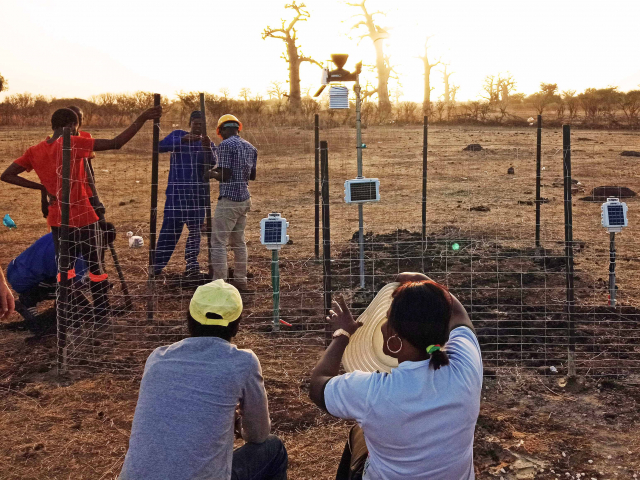17/04/2024 | The Sahel region is a climatic hotspot as it lies right between the moist tropics and the dry subtropics - thus, even small shifts in climate zones can lead to dramatic changes in water availability and its excess there. Yet, there are hardly any reliable, temporally frequent measurements of key meteorological and hydrological variables available for the Sahel. The Dakar region lies right within the Sahel, with a boreal winter associated with near-absence of rainfall and the summer monsoon bringing intense and often hazardous rain yields.
The on-going DakE campaign is building a spatially and temporally high-resolution network of weather stations which are paired with soil moisture measurements - reporting data through the mobile network at 1-min resolution to an open-access archive and a visual data portal. In a joint effort with Senegalese partners at Université Cheikh Anta Diop in Dakar, ZMT researchers spent January and February 2024 in the Sahel region east of Dakar to set up the instruments needed. The current network comprises 13 operational measurement sites, many based at Senegalese primary and secondary schools as well as in two research institutes.
This “observatory” aims to disentangle the internal dynamics of so-called mesoscale convective systems, namely long-lived 100-200 km-clusters of thunderstorms. Such clusters regularly cause flooding in Dakar and surroundings, and especially threaten the urban poor who live in informal settlements. Gusty winds associated with such thunderstorm systems can also threaten the numerous traditional fishers off the west African coast. It is troubling that the ability to reliably forecast such thunderstorm systems is currently very limited, partly due to insufficient data availability at the required resolution.
By collaborating with soil hydrologists at University of Potsdam, Germany, and at the Centre for Ecology and Hydrology, Wallingford (UK) the team led by Jan Haerter (Uni Potsdam and ZMT) has a particular focus in the coupling between soil and atmospheric moisture. It is by no means the case that moist soils imply rainfall to be more likely - it is often the opposite that dry soil “attracts” heavy thunderstorms. Disentangling such riddles from observations and numerical modeling is one of the focuses of the current campaign.
“Another aim of our project is to more practically help improve so-called “nowcasting” - short-term forecasting of flood hazard - for the greater Dakar area”, says Jan Härter. “Such nowcasting could be substantially improved if only satellite data could be calibrated against more accurate rainfall measurements on the ground. The aim is to build a statistical model that can forecast floods, especially in low-lying urban regions at higher reliability - thus reducing the risk to human lives and socio-economic damage.”
In addition, by basing observational stations within school premises and making the data immediately accessible to students and teachers, the project pursues an educational goal of raising awareness of how local weather is quantitatively measured and how the statistics of such weather constitutes climatic information - the climate in this region is likely already undergoing disruptive changes over the years within the Sahel region.
“We aim to discover the internal structure and time evolution of these powerful rain events by employing high-resolution measurements,” says Dr Maxime Colin, postdoctoral researcher in the working group Complexity and Climate at ZMT. “By modelling the data we gain from the weather stations we hope to be able to forecast extreme rainfall events that can cause flooding in the area of Dakar.” In a next step these forecasts could then be used to alert the population and authorities to avoid damage and life loss.
“Working with the Senegalese people from the university and from the villages was a truly great experience. At the schools we showed the pupils and teachers how the stations work, so that they can now read measurements from the station online, draw graphs with the data and thus study the climate in the area around their school. The station will hopefully also spark an interest in science and technology. It’s a bit like a citizen science project in that respect”, says Colin.
The DaKe project is funded by a “Proof of Concept” grant from the European Research Council (ERC). Each grant is worth €150,000. The grant scheme is part of the EU’s research and innovation programme, Horizon Europe.
“With new funding available, the aim is now to further “densify” the network by bringing in an additional 15-20 observational stations,” says Härter. “In addition, different types of instrumentation, able to measure the atmospheric conditions at many altitudes, will likely be drawn in. A major challenge, to be addressed within the coming one to two years, will be to make the network resilient against disintegration over the years.”
Indeed, it is not unusual for field study observatories to break down over the years - due to material failure and lack of maintenance. The aim is to collaborate through joint science to ensure a long-term benefit of the data being recorded by DakE.





